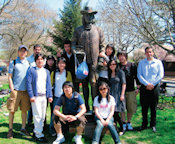Classroom notes
 |
| Local musician Dan Direda plays his "blues harp" for the music class. |
Janet Louise’s English through Music class was visited by musicians who both performed for them and discussed their art form. Taisuke Nishigauchi, a Kobe Shoin Women’s University professor, played a mean banjo as he introduced the history of the instrument and its influence on bluegrass music. Local musician Daniel DiReda brought his blues harp (harmonica) and shared his passion for the heart and soul of blues music.
Grant Wolf’s English as an International Language class gained a deeper understanding of world citizenship by producing a Nobel Peace Prize talk show. Each student researched a Nobel Peace Prize winner, prepared a short PowerPoint presentation and took on the Nobel laureate’s role for a talk-show style interview. Playing the parts of such distinguished world figures as Nelson Mandela, Mikhail Gorbachev, Kim Dae-jung, Jimmy Carter, Al Gore, Wangari Maathai and Mother Teresa enabled students to expand their awareness of how individuals of every race and nationality have made profound and unique contributions to world peace.
Debra Darrell’s News V class followed the story of two natural disasters last spring, the devastating cyclone in Myanmar/Burma and the deadly earthquake in China. After discussing these events and viewing the widespread destruction on the news, the students decided to do something to contribute to the relief efforts. They discovered a website sponsored by the UNWorld Food Program, www.freerice.com, at which visitors can play a vocabulary game resulting in the distribution of free rice to those most in need. The students made posters to promote freerice.com and visited all the other classes to inform students about the website and encourage their participation.
 |
| The News Class in the Multimedia Center |
An ELI news program was produced by Nonie Bell’s News IV and Debra Darrell’s News V classes with multimedia coaching provided by university staff. Students met for four class sessions in the Student Multimedia Design Center (SMDC) to receive instruction in Photo Story software and recording equipment. [See the story on the Multimedia Center.]
They worked in teams to prepare their own news program, choosing topics such as finance, business, human interest, sports, entertainment, arts, food and health. The students then researched their topics, wrote and edited the scripts, found or produced pictures, charts and music, and finally created a series of three-minute narrated productions. The composite news program has been posted on the ELI website, and a selected portion was shown at graduation
While studying important historical figures, Ken Cranker’s Level VI English for Academic Purposes listening/speaking class learned that Knute Rockne, the legendary football coach of Notre Dame University, was also a chemist who discovered synthetic rubber. When a subsequent discussion revealed that many students did not really understand American football, Ken seized the “teachable moment” and developed a PowerPoint presentation on the sport as well as some “hands-on” participation for the more kinetic learners in the class.
 |
| Read It! Watch It! students interview senior citizens |
Leslie Criston’s Read It! Watch It! V class read “Tuesdays with Morrie,” a book about a dying man’s lessons for living a meaningful life. Using the bestseller as a springboard to real communication, Leslie took the students to Newark Senior Center, where they paired up with seniors from the community and interviewed them about aging, lifelong learning and staying active. The seniors, some of whom are in their 80s, are taking computer classes, creating art and teaching poetry courses. Their passion for life was such an inspiration that the class made a second visit in the same session.
Julie Lopez helped students in several of her classes connect classroom practice with real life. For Reading/ Writing IV, the class carpooled to a local private high school to discuss issues in their countries that they had recently written about. Later in the session, the class practiced noun clauses while exploring old New Castle, the site where William Penn first landed.
 |
| Level IV students in old New Castle |
In Sarah Petersen’s English through Broadway class, students worked cooperatively to unravel the plot of the musical “Mamma Mia!” by interpreting individual songs as skits. Each character was played by two people: a silent actor, who showed the story through his/her gestures and facial expressions, and a “dubber” who, behind the scenes, actually spoke the words corresponding to the actions. Separating the functions of communication into words and movement enabled the students to explore the important features of both verbal and physical expression. The resulting skits were taped on digital video, and with the addition of music and special effects, they became an innovative performance at the session VI graduation.
Julie’s English for Academic Purposes VI listening/speaking classes challenged a local high school class to a debate in the fall to get a taste of academic competition with American students.
 |
| EAP VI students celebrate their successful debate with local high school students |